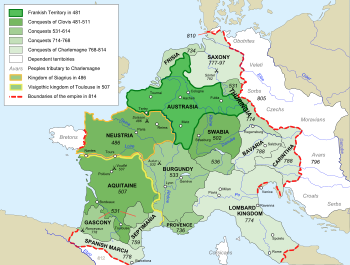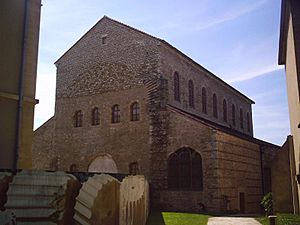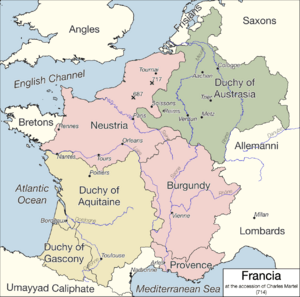Austrasia facts for kids
Quick facts for kids
Austrasia
|
|||||||||||
|---|---|---|---|---|---|---|---|---|---|---|---|
| 511–751 | |||||||||||

Austrasia, homeland of the Franks (darkest green), and their subsequent conquests (other shades of green)
|
|||||||||||
| Capital | Reims, Metz | ||||||||||
| Common languages | Old Frankish, Vulgar Latin (Gallo-Roman), Latin | ||||||||||
| Religion | Christianity | ||||||||||
| Government | Monarchy | ||||||||||
| King | |||||||||||
| Historical era | Early Middle Ages | ||||||||||
|
• Established
|
511 | ||||||||||
|
• Disestablished
|
751 | ||||||||||
|
|||||||||||
Austrasia was an important region in the early Middle Ages. It was the northeastern part of the Kingdom of the Franks. This kingdom was ruled by two powerful families: the Merovingians and the Carolingians.
Austrasia was located around the Meuse, Middle Rhine, and Moselle rivers. It was the original home of the Franks people. The famous Frankish king, Clovis I, conquered this area. He also took control of nearby Roman Gaul, which was later called Neustria.
In 561, Austrasia became its own separate kingdom. It was ruled by the Merovingian king Sigebert I. Later, in the 7th and 8th centuries, the Carolingians rose to power from Austrasia. They started as important officials called "mayors of the palace." They eventually took control of all the Franks, including most of Gaul, Germany, and northern Italy.
After this time of unity, the large Frankish Empire was split again. It became three smaller kingdoms: West Francia, Middle Francia, and East Francia. The eastern kingdom eventually became the start of what we know as Germany.
Contents
What Does Austrasia Mean?
The name Austrasia was not used much in the early Merovingian period. It first appeared around the year 580. The name likely comes from an old Frankish word, *Oster-rike. This means "Eastern Kingdom."
Just like the name Austria, it includes the word "east." So, Austrasia means "eastern land." This name helped tell it apart from Neustria. Neustria was the "new western land" in northern Gaul. King Clovis I conquered Neustria after the Battle of Soissons in 486.
Where Was Austrasia Located?
Austrasia was mainly centered around the Middle Rhine river. This included the areas around the Moselle, Main, and Meuse rivers. To the north, it bordered Frisia and Saxony. To the east, it was next to Thuringia. To the south, it bordered Swabia and Burgundy. To the southwest, it was next to Neustria. The exact border between Austrasia and Neustria was sometimes unclear. This was true for areas like Flanders and Brabant.
Metz was the capital city of Austrasia. However, some Austrasian kings also ruled from Reims, Trier, and Cologne. Other important cities included Verdun, Worms, and Speyer. The Fulda monastery was built in eastern Austrasia during the last years of the Merovingian rule.
Later, in the High Middle Ages, Austrasia's land was divided. It became parts of the duchies of Lotharingia and Franconia in Germany. Some western parts, like Reims, became part of France.
The borders of Austrasia changed a bit over time. But generally, it covered areas that are now part of:
- Luxembourg
- Eastern Belgium
- Northeastern France (like Lorraine and Champagne-Ardenne)
- West-central Germany (like the Rhineland, Hesse, and Franconia)
- The southern Netherlands (like Limburg and North Brabant)
History of Austrasia

After the Frankish king Clovis I died in 511, his four sons divided his kingdom. Theuderic I received the lands that would become Austrasia. Kings from Theuderic's family ruled Austrasia until 555. Then, it joined with other Frankish kingdoms under Chlothar I. By 558, Chlothar I ruled all Frankish lands.
He again divided the land among his four sons. But after Charibert I died in 567, the four kingdoms became three:
- Austrasia, ruled by Sigebert I
- Neustria, ruled by Chilperic I
- Burgundy, ruled by Guntram
These three kingdoms shaped the political map of Francia for a long time.
From 567 to 613, Neustria and Austrasia often fought each other. Burgundy usually tried to keep the peace. These fights were most intense during the wars between Brunhilda (Queen of Austrasia) and Fredegund (Queen of Neustria).
In 613, the nobles rebelled against Brunhilda. She was captured and given to her enemy, Chlothar II of Neustria. Chlothar then took control of all three kingdoms. He created a united Frankish kingdom with its capital in Paris.
During this time, important officials called majores domus or mayors of the palace appeared. These officials helped the king rule each region. The first mayors of Austrasia came from the Pippinid family. This family slowly gained power. Eventually, they took the throne from the Merovingian kings.
In 623, the people of Austrasia asked Chlothar II for their own king. He made his son, Dagobert I, their ruler. Pepin of Landen served as Dagobert's regent (a person who rules for a young king). Dagobert's rule in Austrasia was well-regarded. In 629, he also inherited Neustria and Burgundy.
Austrasia was again less important until 633. Then, the people once more asked for the king's son to be their ruler. Dagobert agreed and sent his older son, Sigebert III, to Austrasia. Historians often call Sigebert the first roi fainéant. This French term means "do-nothing king." His court was mostly controlled by the mayors of the palace.
In 657, the mayor Grimoald the Elder managed to put his own son, Childebert the Adopted, on the throne. Childebert ruled until 662. After this, Austrasia became mainly the kingdom of the Arnulfing mayors of the palace. This family was their main source of power.
In 687, Pepin of Heristal won the Battle of Tertry. He defeated the Neustrian king Theuderic III. This victory made Pepin the mayor over all Frankish kingdoms. People at the time saw this as the start of his "reign." It also showed that Austrasia was now more powerful than Neustria. This lasted until the end of the Merovingian era.
In 718, Charles Martel received support from Austrasia. He fought against Neustria to control all Frankish lands. Charles Martel was not a king himself. But he appointed Chlothar IV to rule in Austrasia. In 719, Martel's family, the Carolingian dynasty, united Francia. Austrasia was the leading power. After the Carolingian dynasty took over, the name Austrasia was used less often.
Rulers of Austrasia
Merovingian Kings
- Further information: List of Frankish kings
- Theuderic I, 511–533
- Theudebert I, 533–548
- Theudebald, 548–555
- Chlothar I, 555–561
- Sigebert I, 561–575
- Childebert II, 575–595
- Theudebert II, 595–612
- Theuderic II, 612–613
- Sigebert II, 613
- Chlothar II, 613–623
- Dagobert I, 623–634
- Sigebert III, 634–656
- Childebert the Adopted, 656–661
- Chlothar III, 661–662
- Childeric II, 662–675
- Dagobert II, 675–679
- Theuderic III, 679–691
- Clovis IV, 691–695
- Childebert III, 695–711
- Dagobert III, 711–715
- Chilperic II, 715–717
- Chlothar IV, 717–720
- Chilperic II, 720–721 (again)
- Theuderic IV, 721–737
- Childeric III, 743–751
Mayors of the Palace
These officials were like prime ministers. They held a lot of power, especially as the kings became less involved in ruling.
- Parthemius, until 548
- Gogo, c.567–581
- Wandalenus, from 581
- Gundulf, from 600
- Landric, until 612
- Warnachar, 612–617
- Hugh, 617–623
- Pepin I, 623–629
- Adalgisel, 633–639
- Pepin I, 639–640 (again)
- Otto, 640–643
- Grimoald I, 643–656
- Wulfoald, 656–680
- Pepin II, 680–714
- Theudoald, 714–715
- Charles Martel, 715–741
- Carloman, 741–747
- Pepin III, 747–751
See Also
 In Spanish: Austrasia para niños
In Spanish: Austrasia para niños
- Francia
- East Francia
- Duchy of Franconia
- Benelux
- Continental Europe


